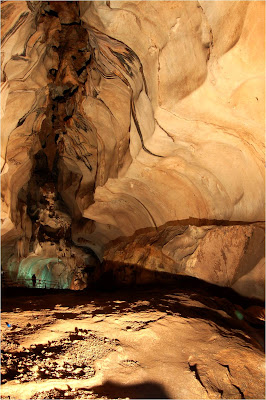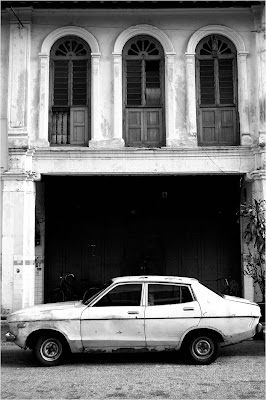No, the wide-angle is for the different perspective; for being able to get closer to the subject while maintaining the background in the frame, and for all those times I'm stuck in a small room or cannot reverse except to certain death.
So, just for fun, I fished out some of my favourite landscapes (place shots as opposed to people shots) to see what sort of focal lengths I used most frequently.

Jetty at Pulau Rawa, off Mersing; May 2007. Shot at 30mm on digital (35mm equivalent: 45mm).
On film this can be achieved with a 50mm lens; no need for wide-angle.

Ruins of St Paul's Hill, Malacca; Dec 2007. 32mm (48mm).
Again, on film this can be achieved with a 50mm lens.

Tomb on St Paul's Hill, Malacca; Dec 2007. 18mm (28mm).
This is what I mean by getting closer to the subject (roots) while keeping the background (ruins) in the frame.

Sky, Cameron Highlands; Dec 2007. 18mm (28mm).
I love this shot. I don't know why I did it, but I pointed the lens upwards and was amazed at the amount of sky I could fit into the frame, somewhat distorting the clouds and the tea fields below.
This, to me, is the point of shooting wide-angle in the first place.

Reading room in Kellie's Castle, Ipoh; Feb 2008. 18mm (28mm).
Another reason for using wide-angles; when the room isn't too large and you can't reverse any more.

Gua Tempurung, outskirts of Ipoh; Feb 2007. 18mm (28mm).
Again, when there's no space to reverse, and when you want to exaggerate perspective.

Old Town, Ipoh; Feb 2007. 28mm (48mm).
Another job for the 50mm; wide-angle unnecessary.
Looks like I tend to use (on digital) 18mm and 30mm thereabouts a lot. Translated into film, these are 28mm and a little wider than 50mm.
Which means a 28mm wide-angle would be just nice. It would serve as an excellent wide-angle on the film camera, and convert to a 42mm slightly-wider-than-normal lens on digital.
I'm also contemplating the 24mm lens, which would be even better for aesthetic purposes, and double as a very usable 35mm on digital. But...
28mm = RM910
24mm = RM1370
That's RM460 of difference, or RM100 per mm!
* * *
On another note, SooT told me today that he recently received a gift of Ilford Delta 100 black-and-white film from a fellow PhD student.
He, Doulos and I are now in pretty much the same boat: one man, one camera, one lens; infite possibilities!
Digital and quality zooms have made everything possible. But here we are, sort-of luddites rowing against the wave of technology...
To be limited by a single focal length.
To not have to worry about zoom; to unleash once again the zooming power of our legs.
To be limited by 36 exposures, between which ISO or colour type cannot be changed.
To not have to worry about colour settings or ISO; to be single-minded, simple-minded and focused.
To be limited by manual focus.
To be free to focus and not be at the mercy of a digital camera's autofocus systems.
Long live photography!
1 comment:
the Gua Tempurung Pic is AWESOME... i doesn't even look like a photo... haha.. more like a painting... How's is Pulau Rawa?? I'm planning to go there with my family.. just haven't really heard of it much...
Post a Comment